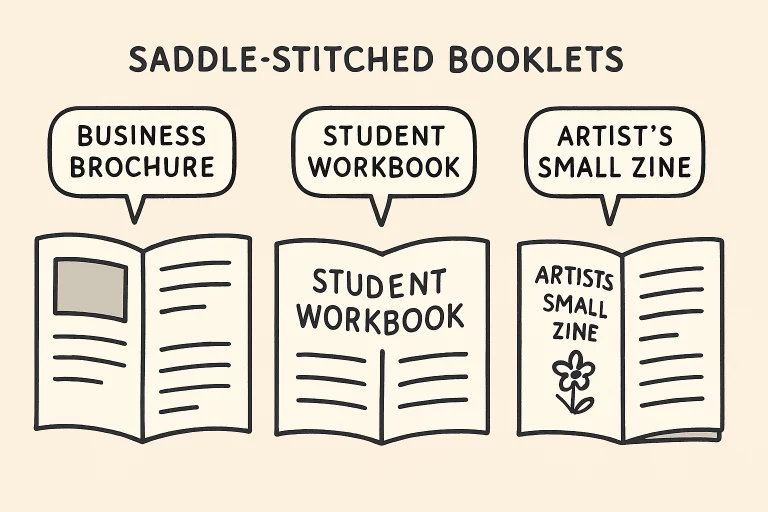Introduction to Saddle-Stitched Booklets
Saddle stitch booklets have become essential for businesses, organizations, and creative professionals seeking a practical, sleek, cost-effective binding solution. This popular binding method involves folding large printed sheets, nesting them inside one another, and securing them along a precisely creased spine with sturdy staples. The result is a clean, streamlined booklet that can be used for various purposes, such as corporate presentations, product brochures, informational packets, annual reports, and so much more. Prized for their lightweight construction and ability to allow booklets to lie perfectly flat when open, saddle-stitched booklets are especially suited for projects ranging from 8 to 64 pages—offering enough room for detailed content without compromising portability or visual appeal.
One of the features that distinguishes saddle-stitched booklets from other binding methods is the way they strike a balance between professional quality and budget-friendly pricing. They can be quickly designed, printed, and distributed with relatively fast turnaround times, making them an ideal choice for short-term campaigns and long-lasting informational materials. Their convenient format, featuring an easy-to-read layout and engaging cover, ensures that content is both accessible and visually compelling, serving the needs of a wide range of industries.
Marketing and Promotional Materials
Within the competitive marketing world, where capturing attention and making a memorable impression can make or break a campaign, saddle-stitched booklets have proven invaluable. They are frequently used to create sleek, polished product catalogs, corporate brochures, event programs, and brand magazines. The clean edges and professional appearance forge a sense of trust and credibility, which can elevate the perception of a brand in the eyes of clients, partners, and prospective customers. Companies eager to leave a lasting impact often select saddle-stitched booklets because they offer high production value without high costs, allowing for larger print runs or more substantial pieces that align with their marketing objectives.
These booklets are commonly distributed at trade shows, conferences, and seminars, where materials must be eye-catching and easy to browse. Their ability to open flat means users can comfortably review detailed product specs, company histories, and pricing guides, all while following calls-to-action cleverly woven throughout. Marketers can take full advantage of the format by integrating vibrant graphics, concise storytelling, QR codes, engaging infographics, and persuasive messaging, all within the adaptable confines of a booklet that feels substantial without seeming overwhelming.
Educational and Instructional Use
The education sector has long recognized the advantages of saddle-stitched booklets, especially for producing materials that need to be durable, accessible, and cost-effective. Schools, colleges, and training organizations frequently utilize this format to distribute workbooks, study guides, course syllabi, lab manuals, and instructional packets. Since these booklets are flexible and can withstand repeated handling, they are a practical choice in busy classrooms and for on-the-go learning environments. The straightforward construction allows for quick updates and reprints, ensuring teachers and trainers can keep educational resources up-to-date without significant lead times.
Another key benefit is the ergonomic design: because saddle-stitched booklets lay flat when opened, students can comfortably take notes, refer back to information, and work on exercises without struggling to keep pages open. Educators can also personalize the layout to suit better the specific subject, grade level, or instructional approach, incorporating diagrams, step-by-step instructions, and collaborative activities that engage students more fully. The adaptability and efficiency of saddle-stitched booklets make them integral to modern educational and training solutions.
Creative and Artistic Publications
For artists, independent publishers, and creative entrepreneurs, saddle-stitched booklets are more than a binding method—they are a blank canvas for creativity and self-expression. This simplistic yet effective structure is favored for producing zines, small art books, mini-portfolios, poetry and short story collections, photo essays, and exhibition guides. The straightforward construction forgoes glue or coil binding, ensures every copy retains a handmade, intimate quality that appeals to readers seeking something unique. The format’s adaptability allows creators to experiment freely with unconventional layouts, striking illustrations, hand-assembled collages, and other personalized touches.
The affordable production cost means that even limited print runs are accessible, empowering independent creators, student artists, and grassroots organizations to share their work without assuming significant financial risk. Whether circulating at arts festivals, bookstores, galleries, or online, these booklets facilitate direct engagement between creator and audience, supporting the kind of experimentation and niche subject matter that might not be possible with other formats.
Enhancing Design with Special Finishes
Elevating a saddle-stitched booklet from a simple publication to an eye-catching, memorable communication piece is easy with special finishing techniques. Publishers and designers have an array of enhancements, including spot UV coating to give select images or text a glossy pop, embossing and debossing for added tactile interest, and foil stamping to add shimmer and luxury to titles or logos. These finishes don’t just catch the eye—they guide the reader’s attention to essential details, distinguishing high-value assets and communicating a sense of care and craftsmanship.
Beyond special treatments, the choice of paper stock can dramatically impact the look and feel of a saddle-stitched booklet. Thick, matte covers convey sophistication and durability, while glossy stocks provide energy and vibrancy—vital for marketing or event materials. Unique or textured stocks can evoke a sense of artistry or exclusivity tailored to the brand or project narrative. Every design choice, from finish to substrate, contributes to reader engagement, making the publication functional and an experience.
Environmental Considerations
Environmental responsibility has become a priority across all sectors, leading to a growing interest in sustainable printing solutions for saddle-stitched booklets. Many organizations now opt for recycled and responsibly sourced paper stocks and eco-friendly, soy-based inks that reduce toxins and support biodegradability. Using sustainable practices helps companies and creatives minimize their environmental footprint, demonstrating a commitment to conservation and ethical production that’s increasingly important to modern consumers.
Today’s audiences care deeply about the values of the brands they support. By choosing greener printing options, companies and institutions contribute to a healthier planet and elevate their reputation with environmentally conscious stakeholders. Implementing sustainable decisions, whether for a handful of promotional booklets or large-scale educational resources, can set an organization apart.
In conclusion, saddle-stitched booklets’ adaptability, accessibility, and professional finish make them a lasting favorite for marketers, educators, artists, and more. When paired with creative design, thoughtful enhancements, and sustainable practices, this versatile binding method delivers impactful communications that resonate with every audience across each industry.

